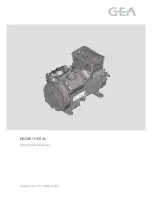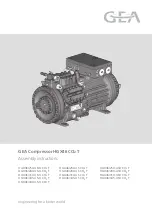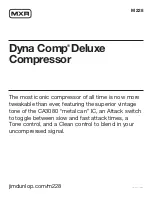
PACIFIC E27 – EG27
12 |
P a g e
PACIFIC E27 – EG27 Rev.00
Nardi Compressori – www.nardicompressori.com
4
INSTALLATION
4.01 UNPACKING AND HANDLING:
The compressor is shipped on pallets and is covered by a box and finally fastened with strapping. After unpacking it is
important to check if the compressor has suffered any damage during transit. If any damage is present, it is important to
inform the carrier and the seller as soon as possible but no later than 7 days after delivery.
The compressor PACIFIC E27 – EG27 is designed to facilitate handling. In fact, if you look at the bottom, you will notice
it has an opening which allows it to be picked up using a forklift.
The compressor is mounted on anti-vibration mounts to avoid transmitting vibration to other things nearby. At any rate, it
must be positioned in a stable location. The pump unit is not resistant to the permanent exposure to marine corrosion. In
the event it comes into contact with corrosive agents it is recommended to clean the surface and protect it with anti-
corrosive spray. Be careful of any electrical parts at all times.
4.02 PLACEMENT IN OPEN AIR:
In order to obtain good quality breathing air it is very important to position the compressor in open
places. The compressor must not suck the exhaust fumes of any internal combustion engine.
If the situation makes this impossible, it is necessary to use an extension for the aspiration of fresh air
to be set higher and as distant as possible from harmful gases/fumes and away from flammable
agents.
Check continuously wind direction and fumes coming from the engine.
The compressors must be positioned in a cool place protected from the weather.
Check Chapter 4.03 for the proximity of walls and roof.
If your compressor is driven by an internal combustion engine it is very important check often the wind
direction of the fumes and exhaust gases coming from the engine.
The compressors must be positioned in such a way that the fumes and exhaust gases are not sucked
by the compressor. If you are not sure about this it would be advisable to us an extension pipe to place
the air inlet at a save location. The compressor driven an a combustion engine must not be used in
closed environments.
4.03 PLACEMENT IN A CLOSED ROOM AND MINIMUM REQUIREMENTS OF THE ROOM:
The compressor placed in a room, requires a continuous recirculation of fresh air.
Inside the room there should be no liquid that can evaporate (solvents, additives, etc.).
The
compressor room must be an absolutely “no
smoking” area.
The compressor must draw unpolluted air and it is preferable to place it in the vicinity of open windows
during its operation so as to ensure recirculation of air both to ensure the quality of the air during the compression phase
as for the cooling of the compressor.
The minimum requirements of the room are the following:
The temperature of the room must not be lower than 5° C and should not be higher than 45° C with proper
ventilation (see Table A).
The room should be dry and clean, there should be no dust that can be sucked by the compressor.
If in the same room two or more machines were placed make sure that the size is adequate (see Table C).
Place the compressor preferably in the coldest area of the room. In the case of natural ventilation make sure that
the compressor is as close as possible to the fresh air intake and that it has the appropriate dimensions. In
addition to this there must be an opening in the upper part of the room that gives the possibility to dispose of hot
air, and also that it has the appropriate size (see Table A and Fig. 2). The two openings should not be on the
same wall, otherwise make sure to direct hot air upwards.













































